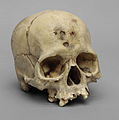Bone Clones
 | |
| Company type | Private Corporation |
|---|---|
| Industry | Manufacturing, distribution, retail |
| Headquarters | Chatsworth, California, U.S. |
Area served | Worldwide |
| Products | Natural human and animal bone reproductions |
Bone Clones, Inc. manufactures, distributes, and sells osteological reproductions of human and animal bones. Located in Chatsworth, California, Bone Clones provides these reproductions to museums, universities, medical schools, and other educational institutions.
History
[edit]Bone Clones creator Dave Kronen became interested in animals during his career as an artist. During the 1980s, he began processing animals in his Woodland Hills studio, carefully and painstakingly mounting the skeletons of lizards, snakes, and other animals.[1] With a supply of animal remains from local zoos, museums began to buy the processed skeletons from Kronen.[2] The idea of replicating real bones out of resin casting came from the increasing demand of museums for processed skeletons. The manufacturing of Bone Clones reproductions began in 1993.[3]




Product
[edit]Bone Clones reproductions are made from a custom blended polyurethane resin.[4] To avoid misrepresentation, all Bone Clones reproductions are stamped with company trademark information.[5]
Bone Clones in museums and colleges
[edit]Bone Clones reproductions have been featured in museums and colleges as part of exhibits and exhibitions. Human reproductions can be seen in the "Footsteps Through Time" exhibit[6] at the San Diego Museum of Man in California. In 2004, Glendale Community College in Glendale, California partnered with Bone Clones, Inc. to create the science exhibit "“Bone: The Hidden Structure of Life." This exhibit showcases skeletons of extinct and extant animals, inviting students and visitors to interact with otherwise inaccessible specimens.[7] In 2012, anthropologist Richard Wright used Bone Clones cast BC-110 to train users in quality control when using his CRANID program for determining the ancestry of unidentified human remains.[8] In February 2014, The American Biology Teacher journal featured an article by Mike Darwin Yerky, who used Bone Clones casts to create an engaging and effective lesson plan in hominin evolution for biology students.[9]
Bone Clones have been featured on television, numerous magazine and newspaper articles and museum exhibitions including:
- "Bone Reproduction Company Does it All – Except the Elephant Man" Flash News
- Knoxville NBC News April 2013
- Wired Magazine
- How It's Made, Season 24 Episode 5
Gallery
[edit]-
Human sphenoid bone
-
Saber-toothed cat skull, Smilodon fatalis
-
Australopithecus afarensis "Lucy" skull
-
Human female with syphilis from the Aleš Hrdlička Paleopathology Collection at the San Diego Museum of Man in California
-
Komodo dragon in walking stance
References
[edit]- ^ Lazzareschi, C (1988) The Business of Bones. Los Angeles Times, January 10: Part IV
- ^ Handel, N (2002) Dem Bones, Dem Clones. Los Angeles Times, 10 March 2002 Retrieved 30 June 2014
- ^ "Bone Clones' amazing replica animal skulls". How To Spend It.
- ^ Handel, N (2002) Dem Bones, Dem Clones. Los Angeles Times, 10 March 2002 Retrieved 30 June 2014
- ^ Sorenson, D (2007) Faux bones flesh out fossil show without letting ethics go extinct. Arizona Daily Star, February 10: A1, A5
- ^ "Among the Lovely Bones". museumofman.org. Archived from the original on 2014-03-28. Retrieved 2014-04-17.
- ^ Barrientos, D (2004) Boning up on science. Glendale News Press, 11 September 2004 Retrieved 30 June 2014
- ^ "CRANID by Richard Wright". si.edu. Archived from the original on 2015-11-23. Retrieved 2014-08-04.
- ^ Yerky, MD. Wilczynski, CJ. (2014) The Mystery of the Skulls: What Can Old Bones Tell Us about Hominin Evolution? The American Biology Teacher, Vol. 76, No.2; Pgs 109-117





